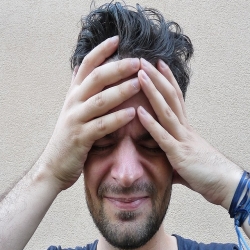Headache
 What is a headache?
What is a headache?
A headache otherwise known as cephalgia simply means pain in the head. It is usually associated with underlying causes. It can also be an alarm to much more serious conditions hence, should not be taken lightly. There are different types of headaches including tension headaches, cluster and migraines. At often people cannot tell whether they have a migraine or a typical headache, arguably the correlation does exist they are all pains in the head. They are differentiated by their severity and intensity. A migraine is much severe, mainly one sided and is associated with symptoms, while a typical or traditional headache is of mild intensity and affects most people.
What can cause a headache?
Anxiety, tearing of a muscle or tendon in the head and stress are some of the causes of tension headaches. General causes such as inadequate sleep, fatigue, alcohol consumption, infections such as sinusitis, flu or cold, meningitis and encephalitis. Dehydration, fasting and regular coffee intake. Vascular diseases like stroke, hypertension and cardiovascular. Brain tumors, head trauma or injury from a fall or road accident.
What are the symptoms?
Tension headaches are often felt on each side of the head. Cluster headaches are one sided but less severe compared to migraine. The pain can be described as pulsating or throbbing, sensation of pressure and heaviness. Migraine is associated with other symptoms such as vomiting, sore eyes, photophobia which is inability to withstand light, dizziness and irritation.
What are the natural cures for a headache?
-Hydration: a major way of getting rid of dehydration, regulating the body and flushing toxins away. drinking plenty of water daily may prevent or relieve a headache.
-Relaxation: taking a warm bath or shower, you can also dip a cloth in warm water and apply it on the head and reduce stress by meditating, get a body massage. Whatever relaxes you, improves blood circulation.
-Diet: eat a lot of almonds, they contain salicin which reduce pain, avoid or limit alcohol consumption and coffee. Stray from the use of recreational drugs.
-Sleep: get enough sleep, have regular sleeping hours.
-Cayenne: contains capsaicin which numbs pain. Add half a teaspoon of cayenne powder to half a cup of warm water, dip cotton into the solution and put in nostrils. This burns but it reduces the headache.
-Apple cider vinegar: pour boiled water in a bowl, add a quarter of vinegar, then put a small blanket or towel over your head and inhale the steam. Careful not to burn your face ,don't lean into the bowl closely, take breaks when necessary and stop when the water becomes warm and steamless.
-Ginger and lemon: make ginger tea, add a slice of fresh lemon into it. Drink this twice daily. The use of fresh ginger root is advised.
-Peppermint: can be used in three ways, either by boiling dried its dried leaves, strain and add honey to taste. Or simply inhaling the scent of peppermint oil. This helps with normal blood circulation. The third way is by making paste by crushing fresh leaves, and applying it where the pain is, laying down for a while to allow its effect to fully work.
Lavender oil or rosemary oil: smear the oil behind your neck and massage gently.
Please note that the herbal oils are not to be taken orally.
The persistence of headache despite trying out various herbal treatments could mean deeper internal cause, in that case do not hesitate to seek help of a physician. Otherwise, herbal treatment show no or less side effects compared to modern medication.